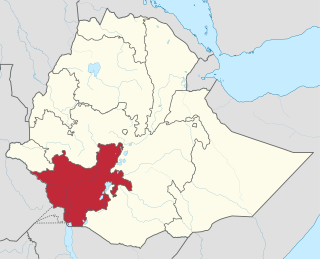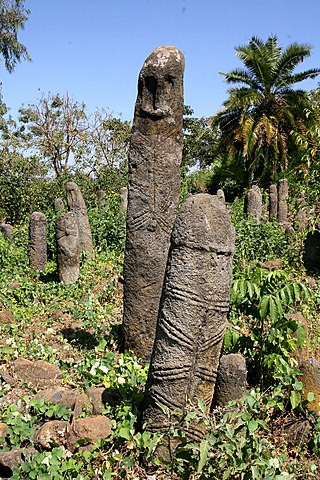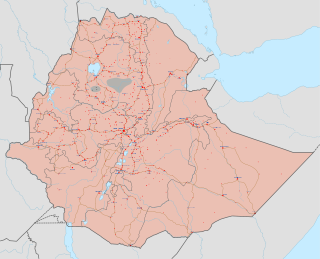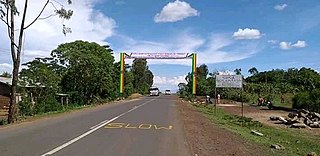
The Southern Nations, Nationalities, and Peoples' Region was a regional state in southwestern Ethiopia. It was formed from the merger of five kililoch, called Regions 7 to 11, following the regional council elections on 21 June 1992. Its government was based in Hawassa.
Dilla is a market town and separate woreda in southern Ethiopia. The administrative center of the Gedeo Zone in the former Southern Nations, Nationalities, and Peoples Region (SNNPR) now it is South Ethiopia Regional State (SER), it is located on the main road from Addis Ababa to Nairobi. The town has a longitude and latitude of 6°24′30″N38°18′30″E, with an elevation of 1570 meters above sea level. It was part of Wenago woreda and is currently surrounded by Dilla Zuria woreda.

Gedeo is a zone in the South Ethiopia Regional State (SERS) of Ethiopia. This zone is named for the Gedeo people, whose homelands lie in this zone. Gedeo is an exclave of the SERS consisting of a narrow strip of land along the eastern escarpment of the Ethiopian Highlands. It is surrounded by the Oromia Region, which borders the Zone on the east, south and west; Gedeo shares its northern boundary with the Sidama Region. Dilla is the administrative center; other towns include Dilla, Wonago, Yirgachefe, Chelelekitu and Gedeb.

The Sidama Region is a regional state in southern Ethiopia. It was formed on 18 June 2020 from the Southern Nations, Nationalities, and Peoples' Region (SNNPR) and transformation of the Sidama Zone after a 98.52% vote in favour of increased autonomy in the 2019 Sidama referendum. It is the second smallest regional state in the country, after Harari. Sidama is the name of both the Sidama people, the language, and the territory. Sidama is bordered to the south by the Oromia Region (except for a short stretch in the middle where it shares a border with Gedeo zone, in South Ethiopia Regional State, on the west by the Bilate River, which separates it from Wolayita Zone, and on the north and east by the Oromia Region. Towns in Sidama include Hawassa, the capital of Sidama and of SNNPR when it existed, Yirgalem, Wondogenet, Chuko, Hula, Bona, Bursa, Bensa, and Aleta Wendo. Sidama has a population of around 3.2 million in 2017 who speak the Cushitic language Sidama.
Adola is one of the woredas in the Oromia Region of Ethiopia. It is part of former Adolana Wadera woreda what was divided for Adola, Girja and Wadera woredas and Adola town. Part of the Guji Zone, Adolana Wadera was bordered on the south by Liben, on the southwest by Odo Shakiso, on the west by Bore, on the north by the Southern Nations, Nationalities, and Peoples Region, and on the east by the Bale Zone.

Dawuro is a zone in the Southwest Region of Ethiopia. The name "Dawuro" represents both the land and the people. It is located at about 500km southwest of Addis Ababa, the capital of Ethiopia, about 111 km west of Wolaita Sodo, the capital of South Ethiopia Regional State and 319 km of Hawassa the capital of the Sidama Region. Dawuro is bordered on the south by Gofa Zone, on the west by the Konta Zone, on the north by the Gojeb River which defines its boundary with the Oromia Region, Jimma zone, on the northeast by Hadiya and Tembaro Special Woreda in Central Ethiopia Regional State, and on the east by Wolayita Zone; the Omo River defines its eastern and southern boundaries.

Wolayita or Wolaita is an administrative zone in Ethiopia. Wolayita is bordered on the south by Gamo Zone, on the west by the Omo River which separates it from Dawro, on the northwest by Kembata Zone and Tembaro Special Woreda, on the north by Hadiya, on the northeast by the Oromia Region, on the east by the Bilate River which separates it from Sidama Region, and on the south east by the Lake Abaya which separates it from Oromia Region. The administrative centre of Wolayita is Wolaita Sodo. Other major towns are Areka, Boditi, Tebela, Bale Hawassa, Gesuba, Gununo, Bedessa and Dimtu.

Megaliths in Ethiopia are large, monumental stones, that exist in Ethiopia.

Dimtu or Wolaita Dimtu or Bilate Tena is a town in south-central Ethiopia. It has an elevation between 1,000 and 1,600 metres above sea level. It was part of the former Damot Weyde (Woreda) of Wolayita Zone, near to Sodo Zuria woreda. It is now under the Diguna Fango woreda. Some writers mention the town as Bilate Tena in their books and journals. Among them, Getahun Garedew, former Head Officer in Education Bureau of Southern Nations, Nationalities, and Peoples' Region, and State Minister of Ministry of Education since 2020, is the anterior. In the book "Local Adaptation Practices in Response to Climate Change in the Bilate River Basin, Southern Ethiopia", he used these two names, Dimtu and Bilate Tena, in a similar way.
The Transitional Government of Tigray was a caretaker administration that was formally declared by the House of Federation of Ethiopia on 7 November 2020, in the context of a conflict between the Tigray People's Liberation Front (TPLF), in power in the Tigray Regional State and the federal government of Ethiopia. In late November 2020, the administration, headed by Mulu Nega, planned public consultation and participation in choosing new leaders at the regional and zonal level and preservation of woreda and kebele administrations. The Transitional Government left Tigray in late June 2021 during Operation Alula.

The ongoing Ethiopian civil conflict began with the 2018 dissolution of the Ethiopian People's Revolutionary Democratic Front (ERPDF), an ethnic federalist, dominant party political coalition. After the 20-year border conflict between Ethiopia and Eritrea, a decade of internal tensions, two years of protests, and a state of emergency, Hailemariam Desalegn resigned on 15 February 2018 as prime minister and EPRDF chairman, and there were hopes of peace under his successor Abiy Ahmed. However, war broke out in the Tigray Region, with resurgent regional and ethnic factional attacks throughout Ethiopia. The civil wars caused substantial human rights violations, war crimes, and extrajudicial killings.

Tebela or (Wolaita: Xabala) is a city in Wolaita Zone South Ethiopia Regional State. Tebela is an administrative capital of Humbo woreda district of Wolayita Zone. Tebela is located about 345 km away from Addis Ababa to the south. And also, Tebela is located 20 km, South from Sodo, the capital of the region and also Wolayita Zone. The coordinate point of the town in map is 6°42′24″N 37°46′10″E. The amenities in the town are; 24 hours electricity, pure public water, banks, primary and secondary schools, postal service, telecommunications services health centre, private clinics, drugs store, public market, public road light around high ways, internal and town crossing asphalt roads and others.

Kercheche or is a town in Diguna Fango woreda, Wolayita Zone of South Ethiopia Regional State. Kercheche is about 10 km (6.2 mi) north of Bedessa and about 8 km (5.0 mi) southwest of Bitena on the road of Sodo-Dimtu Hawassa. The approximate distance from the city of Addis Ababa to the town is 362 km (225 mi) on Addis-Hawassa-Dimtu-Sodo road. It is 38 km (24 mi) from Sodo, the capital of Wolayita Zone. The coordinate point of Kercheche lies between 6°57'21"N 37°59'29"E. The amenities in the town are 24-hours electric light, pure water service, kindergarten, primary school, high school, all time market, health stations and others. Kercheche has also dry weather and all weather roads which connect it to other surrounding areas.
Kawo Koysha is one of the woredas in the South Ethiopia Regional State of Ethiopia part of the Wolayita Zone. Kawo Koysha is bordered on the south by Offa woreda, on the west by the Kindo Didaye, on the north and east by Kindo Koysha. Kawo Koysha woreda was established in 2019 from the surrounding woredas. The administrative center of this woreda is Lasho Town.
Bombe is a town in Wolayita Zone of the South Ethiopia Regional State, Ethiopia. Bombe town is located 325 km (202 mi) and 55 km (34 mi) away from Addis Ababa and Wolaita Sodo town through Hossana exit, respectively. Bombe town is used as an administrative capital of Boloso Bombe woreda of Wolaita Zone. It is located at an elevation of 1,531 meters (5,023 ft) above sea level. The amenities in the town are 24 hours electric light, pure water service, kindergarten, primary and high schools, health center, everyday public market and others. Bombe lies between about 7°08'04"North 37°34'54"East
Gacheno is a town in Wolayita Zone, South Ethiopia Regional State, Ethiopia. Gacheno is located about 287 km via B51 away from Addis Ababa to the south and also 31 km away from Sodo to the North, the capital of Wolaita Zone within Damot Gale woreda. The town is located at an elevation of 1,882 meters above sea level. Gacheno lies between 7°03'22" N and 37°55'14"E. The Ethiopian 3rd lady Roman Tesfaye was born and completed her primary school in this town.

Firew Altaye Gebremedhin or ፍሬው አልታዬ ገብረመድህን was born on 2 August 1966. He was an Ethiopian politician and second chief administrator of Wolayita Zone, from 2002 to 2004 and he was succeeded by Amanuel Otoro. He served as member of Ethiopian parliament from 2001 to 2002.
Edo is a town in Wolayita Zone of the Southern Nations, Nationalities, and Peoples' Region, Ethiopia. Edo town is located 310 km away from Addis Ababa and also 47 km from Wolaita Sodo town through Kercheche. The town is located in the north west edge of Diguna Fango woreda. Agricultural products are highly available in Edo town market which are produced from surrounding communities. The amenities in the town are 24 hours electric light, pure water service, kindergarten, primary and high schools, health center, everyday public market and others. Edo town lies between about 7°01'28" North 38°0'30" East. And the town located at an elevation of 1,730 meters above sea level.
This is part of the series of violence between minorities in the Southern Nations, Nationalities, and Peoples' Region (SNNPR) and West Guji Zone of the Oromia regions, causing frequent attacks against ethnic Koore and other minorities in the Amaro special woreda and surroundings. Ethiopian Human Rights Council underscored the increasingly frequent nature and spread of conflicts and security issues in the area and called for preventative measures.











